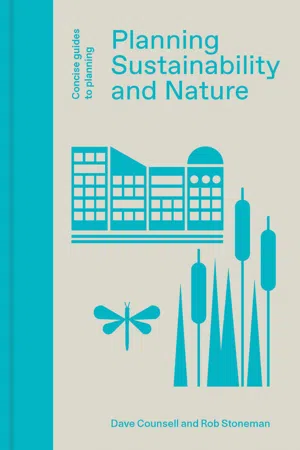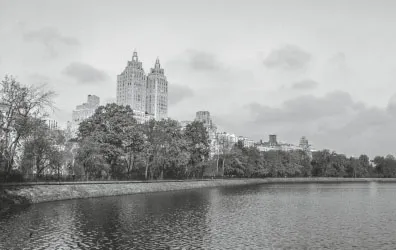![]()
Chapter 1
Changing Approaches
Introduction
This chapter explores regulatory and policy development for nature conservation in the United Kingdom and Europe. It illustrates how early UK legislation and the European Union Nature Directives focused largely on protecting rare and declining species of plants and animals and the best examples of their habitats; many of these relatively small areas. New approaches were sought which looked at conservation more holistically and at much greater spatial scales. Many of these ideas were brought to the attention of the British Government in an influential report, Making Space for Nature: A Review of England’s Wildlife Sites and Ecological Networks (2010). They were subsequently incorporated into a White Paper on the Natural Environment and into the National Planning Policy Framework and Planning Policy Guidance. Similar themes are addressed in policy statements emerging from Europe such as the EU’s Biodiversity Strategy to 2020.
Origins of nature conservation in the UK
Conserving land for nature has a long history in the UK. Wild areas of land, such as the royal forests in England, have been given a degree of protection since Norman times, though these were managed largely for the protection of game (principally deer and wild boar), not for the natural environment itself. Nevertheless, Forest Law did protect many areas of woodland and heath which might otherwise have been cultivated. The New Forest is a prime example of a royal forest whose habitat has survived to the present time and even retains the medieval court that looks after its interests: the Verderers.
The origins of the modern conservation movement can be found in the natural history societies established during the nineteenth and early twentieth centuries, for example Royal Society for the Protection of Birds (1889), National Trust (1895), Society for the Promotion of Nature Reserves (1912, now the Royal Society of Wildlife Trusts). Charles Rothschild published the first comprehensive list of potential nature reserves in the UK in 1915. Early conservation movements also arose in the United States where the focus was on the preservation of wilderness – the first national park in the world was Yellowstone in 1872, followed by Yosemite in 1890.
Parallel to movements to protect wildlife in the countryside were movements to provide accessible green areas in towns. Urban parks had been established as early as the seventeenth century (Hyde Park, 1637) but the main period of park development was in the nineteenth century, by the end of which citizens of most northern industrial towns and cities had access to parks. In the United States parks were created at a greater metropolitan scale, New York’s Central Park (1857) being a prime example. The late nineteenth century also witnessed the birth of the garden city movement based on the writings of Ebenezer Howard – new self-sufficient communities living in the countryside surrounded by greenbelt and built around a central garden hub.
Central Park, New York.
Development of UK nature conservation policy
During the height of the Second World War, with bombs raining over London, civil servants, experts, policy makers and academics began planning for the peace. Organised by the Society for the Promotion of Nature Reserves (now the Royal Society of Wildlife Trusts), one such grouping got together for a conference on Nature Preservation in Post-War Construction in 1941.1 By 1942 this had morphed into a formal Government Committee: the Nature Reserves Investigation Committee, leading to a Green Paper – Command 7122 Conservation of Nature in England and Wales – that detailed how to set up a state nature conservation system in the UK.2 Eventually, this led to the groundbreaking 1949 National Parks Act, with the Peak District becoming the UK’s first national park in 1950. This Act did much more than simply set up national parks. It organised the UK’s first state nature conservation service – the Nature Conservancy; it set out legislation to protect biologically rich areas as Sites of Special Scientific Interest (SSSI) to be conserved through the local planning system; and it empowered the Nature Conservancy to declare and manage National Nature Reserves and local authorities to do the same for Local Nature Reserves.
The reconstruction of post-war Britain had wildlife and landscape at its heart. Yet, despite such efforts, wildlife began to decline at an alarming rate. In part this was due to gamekeepers who shot out many predators in the countryside to protect recreational shooting. Some of this was addressed through the 1954 Wild Birds Act that made it illegal to kill or take the eggs of all birds, apart from some pest species. However, rapid development destroyed some of the best sites for wildlife (see Case Study 1) whilst the ‘juggernaut’ of intensive agriculture massively reduced the diversity and abundance of wildlife across the UK countryside.3 For example, of the 182 potential nature reserves identified by Rothschild and his associates in England at the beginning of the twentieth century, 21 have now been completely destroyed and 142 partially destroyed. All but 19 have suffered little or no loss.4
Indeed, designation of sites under the National Parks Act as SSSIs was actually rather weak. All that was required under the legislation was for the Nature Conservancy (and its successors) to notify local planning authorities that an SSSI existed. The Nature Conservancy was given the power to enter into management agreements with landowners to maintain the interest of SSSIs with the Countryside Act of 1968 but was given little resource to enact such agreements.
Case Study 1
Cow Green Reservoir
Upper Teesdale is famed by botanists for its outstanding diversity of rare alpine and arctic flora – plants such as mountain avens, marsh saxifrage, hoary rock-rose and spring gentian – particularly over outcrops of sugar limestone. In 1967, when chemical company ICI applied to flood part of Upper Teesdale, conservationists were horrified and launched a massive campaign. Despite SSSI status, the campaign failed, and Cow Green Reservoir was built, but politicians were taken aback by the vehemence of the campaign and within a few years the first Ministers for the Environment were appointed. The weakness of legislation designed to protect Britain’s wildlife was horribly exposed.
Legislative weakness in protecting important wildlife sites was exposed again and again. Construction of the M3, for example, had the look of an SSSI dot-to-dot map with the motorway slicing through SSSI heathlands and woodlands all along its route. Through the 1970s, non-governmental organisations (NGOs) lobbied for stronger protection, arguing for legislation to stop damaging activities on SSSIs.
This led to the Wildlife and Countryside Act (1981). With this Act, the Nature Conservancy Council (NCC) was given powers to notify all owners and occupiers of the special features of SSSIs as well as placing a requirement on SSSI managers to notify the NCC before carrying out any potentially damaging operations. At this stage, the NCC could attempt to discourage SSSI managers from damaging the site or negotiate compensatory management agreements for profits foregone as a result of not carrying out a damaging operation. The approach helped but did not stop the continued destruction of the UK’s best wildlife sites.
The road-building programme during the 1980s was particularly infamous with the A34–M40 (Southampton to Birmingham) route (see Case Study 2) leading to dramatic road protests that mired the projects in controversy and added huge extra costs. The Newbury bypass protests were particularly active, with tree houses and tunnels, making one of the protestors (Daniel Hooper, aka Swampy) so famous he appeared as a guest on Have I Got News for You on BBC1.
Case Study 2
St Catherine’s Hill
Perhaps one of the worst examples of environmental damage due to road building occurred at St Catherine’s Hill. Just outside Winchester, this Hampshire and Isle of Wight Wildlife Trust Nature Reserve contains unimproved chalk grassland. Chalk grasslands were once common across the chalklands of England, a grassland habitat first developed by domestic grazing in Neolithic times. These grasslands are rich in flowers supporting diverse assemblages of butterflies and moths. In the 1950s, chalk grasslands were still abundant – Lousley, for example, noted that ‘the short dense turf occupied countless acres of Wiltshire, Hampshire, Berkshire and Dorset downland’.5 However, artificial fertilisers allowed farmers to plough these grasslands, creating arable land, and only a few fragments remain, mainly on steeper slopes such as St Catherine’s Hill. The Hill also contained exceptionally important archaeology – an Iron Age hill fort, barrows, burial mounds and a medieval maze. Not surprisingly, St Catherine’s Hill was one of the earliest SSSIs to be designated in 1951, just two years after the 1949 National Parks Act came into force. Despite this designation and its obvious importance, the A34 was rerouted straight through the middle of the nature reserve by building a huge cutting.
Another issue is that SSSI designation was never meant to be comprehensive. The series was set up to be representative of the wildlife it sought to protect. The intention was that SSSI designation was simply one mechanism to conserve wildlife, with published guidelines noting that nature conservation was just as essential outside the network, but that non-statutory means such as advice, education and persuasion had to be used.6 In essence, most wildlife-rich sites were not designated and had no protection.
Local Wildlife Sites offered a more formal means for providing local authorities with such advice. Groups of experts, often including local naturalist organisations, The Wildlife Trusts and local authority ecologists, formed local committees to select those sites that were important for wildlife but not (or yet to be) designated as an SSSI. Local authorities, recognising the robustness of the system, often included these sites into local plans, adding planning guidance to steer development away from these sites. Different authorities used and still use different terms – Sites of Importance to Nature Conservation (SINCs), Sites of Biological Importance (SBIs), County Wildlife Sites (CoWS). Collectively they are known as Local Wildlife Sites. In effect, these sites are afforded the same protection as SSSIs used to have prior to the 1981 Wildlife and Countryside Act – they are a non-statutory method of providing local authorities information in relation to planning development. Many local plans are explicit that development will generally be refused if it damages or destroys a Local Wildlife Site, unless there are overriding reasons (see Chapter 6).
International developments in nature conservation policy
Wildlife conservation was as much an international as a national affair in the post-war period, with the development of the International Union for the Protectio...







